Prof Ujjwal K Chowdhury ignites the debate on the need Vs its negative ecological, social and economic costs of ‘Fast Fashion’ and advocates the benefits of ‘Sustainable Fashion’ or Happy Fashion!
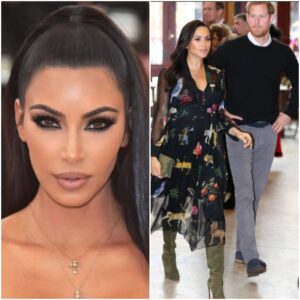
Recently, on 25th April, 2019, The Guardian of UK has reported, “With Meghan, Duchess of Sussex, and Kim Kardashian spotted in vintage wear, and its increasing availability on the high street, it could be the answer to sustainable shopping.” Please note, vintage wear is about second hand clothing.
The world is taking note of the humongous negative ecological, social and economic costs of ‘Fast Fashion’ and moving towards what different people have called as Sustainable or Eco or Slow or Ethical Fashion. The minor differences among these terms apart, I would like to call it as the rise of the Happy Fashion, and we now need to make it the new style statement.
At the outset I hate to break it to you, but there is no such thing as being 100% sustainable with fashion. The first reason being washing clothes already takes a toll on the environment through the use of water, electricity, and most laundry detergent is not eco-friendly. There are, however, many different ways of approaching the topic that one can learn from, to become more sustainable and decide where one stands.

What is Fast Fashion?
Fashion is, per definition, a phenomenon related to time: a popular style in a certain time and context. This also affects the perception of what is and should be made more “sustainable” – if fashion should be “fast” or “slow”, if it should be more exclusive or inclusive.
“Fast Fashion Is the Second Dirtiest Industry in the World, Next to Big Oil”, noted Eileen Fisher, a clothing industry magnate and a major designer globally. Determining fashion footprint is tough due to the variety from one garment to the next. The obvious pollutants are: the pesticides used in cotton farming, the toxic dyes used in manufacturing and the great amount of waste discarded clothing creates—but also the extravagant amount of natural resources used in extraction, farming, harvesting, processing, manufacturing and shipping.
Fast fashion mentions those clothes where the designs move from catwalk quickly to capture current fashion trends, quickly moving from runway to store to consumer, and also to the garbage. The emphasis here is on optimizing certain aspects of the supply chain for these trends to be designed and manufactured quickly and inexpensively, and obviously cheaply with synthetics or chemical dyes, etc, to allow the mainstream consumer to buy current clothing styles at a lower price.

Used by large brands Zara, C&A, Peacocks, Primark, Xcel Brands, and Topshop, etc, China has emerged as the largest exporter of fast fashion, accounting for 30% of world apparel exports. Retail revolution within the U.S. (example Wal-Mart, Target, Nike) and Western Europe has fuelled it, where companies no longer manufacture but rather contract out their production and have transformed themselves into key players in design, marketing, and logistics, introducing many new different product lines manufactured in foreign-owned factories in China & Bangladesh.
Fast fashion has a lot many challenges, including mass production of cotton. While Uzbekistan is an extreme example of how cotton farming can wreak havoc on the environment guzzling huge amount of water, the negative impact of cotton agriculture is felt in other regions, including Pakistan’s Indus River, Australia’s Murray-Darling Basin and the Rio Grande in the U.S. and Mexico. Dyes are creating a chemical Fukushima in Indonesia. The Citarum River is considered one of the most polluted rivers in the world due in great part to the hundreds of textile factories lining its shores.
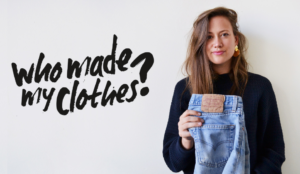
As production and labor costs rise in China, the largest producer of clothing, clothing companies are moving to countries where manufacturing is cheaper: places like Bangladesh, Vietnam, Pakistan and the Philippines, importing cotton from China and India. Fast fashion, poor infrastructure and poorer wages compounded to kill nearly 1135 workers in the Rana Plaza garment factory accident on April 24, 2013, and since then April 24 has been observed as Fashion Revolution Day world-over, calling for Slow and Sustainable Fashion, and to encourage people to investigate and question the origin of their clothes, through a movement named #WhoMadeMyClothes. This hashtag resulted in 6.6m Google hits worldwide in 2015. Major international news publications and fashion magazines covered the FRD story, including British Vogue and Marie Claire.
Slow & Sustainable Fashion:
The slow fashion or conscious fashion movement has arisen in opposition to fast fashion. Elizabeth L. Cline’s 2012 book, Overdressed:The Shockingly High Cost of Cheap Fashion, was one of the first investigations into the human and environmental toll of fast fashion. She used the term Slow Fashion first. Slow fashion is a fashion concept that reflects a perspective, which respects human living conditions, biological, cultural diversity and scarce global resources and creates unique, personalized products. Slow fashion consists of durable products, traditional production techniques or design concepts that are season-less.
Organic cotton, a sustainable alternative for fabric: grown in a way that uses methods and materials that lessen the impact on our environment. H&M largest buyer of Organic Cotton. Eileen Fisher’s company is already using 84 percent organic cotton, 68 percent organic linen and is reducing water use and carbon emissions and working to make its supply chain sustainable by 2020.
Sustainable fashion is a part of the growing design philosophy and movement towards environmental and social sustainability. Sustainable fashion therefore belongs to, and is the responsibility of citizens, public sector and private sector.
Through the utilization of recycled material for the manufacturing of clothing, this provides an additional realm of economic world profit. Sustainable Clothing provides a new market for additional job opportunities, continuous net flow of money in the economy, and the reduction of raw materials and virgin resources. Source reduction or reducing the use of raw materials and virgin resources can ultimately reduce carbon emissions during the manufacturing process as well as the resources and carbon emissions that are related to the transportation process. This also prevents the unsustainable usage of extracting materials from the Earth by making use of what has already been used (i.e. recycling).
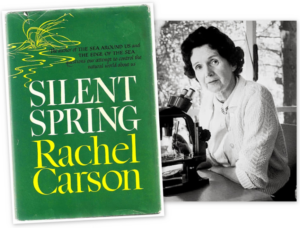
In 1962, the book Silent Spring by American biologist Rachel Carson started it all. Then sustainable development term was coined in 1987 by the Brundtland Report. United Nations conference on Environment and Development in 1992, popularly known as the Rio Earth Summit, ‘green issues’ (as they were called at the time) made their way into fashion and textiles publications. Sustainability calls for an urgent need to place environmental, social, and ethical improvements on management’s agenda. The goal of sustainable fashion is to increase the value of local production and products, to prolong the lifecycle of materials, to increase the value of timeless garments, to reduce the amount of waste, and to reduce the harm to the environment. It also attacks the greed for more, the basis of modern era consumerism, and calls for fulfilling need and with quality product as against greed to have more with low quality cheaper but severely harmful clothes.
Anti-fashion movement and its manifesto was also conceived as a part of the sustainable fashion movement through #BoFVoices: Talk by Li Edelkoort (Lidewiz). She said that pure sustainable fashion is unviable, but let us move towards clothing and industrial fashion design for masses, not individual designs for catwalk with limited textile knowledge, but better priced, less volume, lower consumption. Design & marketing can together, through serial ads campaign, and consumers as ambassadors ahead.
So, an organization has come up named FashionRevolution.org. And it has produced Fashion Transparency Index 2019. Which focuses on the answer to: Who made my clothes? It calls for Transparency TO Accountability TO Change. Those companies who scored above 61% on transparency: Adidas, Reebok, Patagonia, Esprit, H&M. None scored above 71%.
Goals of Sustainable Fashion:
- (A) Reduce: consumers need to drastically reduce the number of many cheap clothes and have better quality, eco-friendly and expensive lesser clothes (at comparable costs finally).
- (B) Reuse: Only around 20% of clothing is recycled or reused, huge amounts of fashion product end up as waste in landfills or is incinerated. The average American throws away nearly 70 pounds of clothing per year. This is affecting China and India too.
- (C) Recycle: The limited range of recycled materials available reflects the market dominance of cheap virgin fibres and the lack of technological innovation in the recycling industry, which can be harnessed to create new value chain of older clothes.
- (D) Upcycle: Upcycling creates something new and better from the old or used or disposed clothes. Upcycling aims at the development of products truly sustainable, affordable, innovative and creative. For example, downcycling produces cleaning rags from worn T-shirts, whereas upcycling recreates the shirts into a value-added product like unique handmade braided rug. Exampl: RECLAIM brand by Orsola de Castro
India’s Top Sustainable Brands:
1. Upasana
They’ve designed special projects and worked closely with various communities across the country. Varanasi Weavers is one such programme & Kapas is another project aimed at helping organic cotton farmers in Madurai.
Calls for ‘100% organic, 100% fair trade clothing’. They pay fair wages to farmers and also offer them premiums for community development.
With studio in New Delhi, it works with marginalised women producers and artisans from different countries like Afghanistan, Laos, Uzbekistan and Cambodia, using handmade and upcycled materials to create beautiful apparel, accessories and jewellery.
4. Ba No Batwo
‘Reduce, reuse, recycle’ being its slogan, the brand collects waste such as plastic bottles, discarded clothes, cosmetic containers etc to design and create jewellery, bags, wallets and stationery.
5. Brown Boy
Brown Boy stands for everything that fast fashion does not, and only 100% fair trade certified cotton is used in the making of its products.
6. Ka-Sha
It has unique ways of creating beautiful garments and accessories out of scraps and objects usually considered waste by many.
7. Ethicus
The company believes in inclusive growth and measures their success not just by the profits but also by the improvement in the standard of living of its employees. Each product carries a tag with the name and picture of the weaver.
8. 11:11
Eleven eleven makes dedicated attempts at promoting khadi (handwoven natural fabric from the subcontinent), specially the concept of ‘luxurious khadi’, completely handmade and dyed naturally using colours extracted from barks, petals and leaves.
9. Doodlage
Armed with the mission to create zero waste, Doodlage makes use of left-over and discarded fabrics from large manufacturers. They also use eco-friendly materials like organic cotton, corn and banana fabric.
10. Paromita Banerjee
Paromita Banerjee is a passionate advocate of handloom products.
11.Péro
Reinventing traditional styles to modern customers aesthetics, péro’s sensibilities evoke an innocent statement in everyday dressing.
12.Behno
They focus on manufacturing garments and accessories from a garment worker perspective and adheres to international factory standards and fair wages.
13.Bhusattva
It is one of the earliest defenders of sustainability in the Indian textile industry and has a 100% organic cotton unit based in Gujarat.
14.Do You Speak Green?
The brand unites its sense of aesthetics to its sense of ethics and gives us a range of eco-friendly yoga and casual wear for both men and women. This is a fair-trade and GOT’s certified brand that rubbishes the assumptions of organic as expensive clothing.
15.Mrinalini
It is a zero-waste collection of relaxed styles and classic clothing in natural and hand woven fabrics.
16. Maati Crafts
It is an organisation that celebrates the cultures and traditions of India, producing indigenous clothing, hand woven and handmade.
17. OLIO
It brings in concept clothing, where form and functionality coincide as beautiful designs. Their collection, Bean, is 100 per cent khadi cotton.
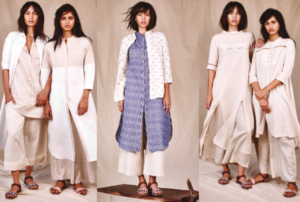
18. Anita Dongre Grassroot
They work with NGOs like Mijwan, SEWA, and Khamir in Kutch, to create products that marry design with social consciousness.
19. Nicobar:
This brand takes on the tropical style the whole year around, with enough changes in each collection to reflect the particular season.
20. Love The World Today
Inspired by childhood and crafted for children, it has sustainable clothing for girls and boys so that their love for khadi begins early.
Why & How Consider Sustainable ‘Happy’ Fashion?
Sustainable fashion is not about the high price it usually has, but about the ecological costs considerations due to cheap fast fashion. If you make sustainable, ecology and fair wages to labour as priorities, you’re going to spend more as consumer and you’re going to charge more as a seller. There are ways to partly compensate for these high costs by making innovative changes to the standard business model (for example, selling directly to the consumer.
A limited number of manufacturers of T-shirts and regular clothes hold to ethical and environmental manufacturing standards. The high-quality companies that prioritize these values are also out there, but they are few, which makes them unique and special. Even with referrals, the only way to guarantee that the garments you brand and sell are being manufactured in a clean, safe, ethical facility is to see it for yourself. In other words, you’re going to have to travel (a lot), meet with manufacturers personally (a lot), and get a firm agreement that the facility you inspected will be the actual facility used to source your materials.
Though you may have found a manufacturer you are happy with, you still must pay attention to every link in your supply chain. When sourcing Polos, T-shirts, and denim, you will find that there are multiple companies in the supply chain: One that purchases the cotton and then knits the fabric, another that dyes the fabric, a third that washes the fabric, then the company that manufactures the product (cutting, sewing and assembly), and all in the chain must ensure a commitment to healthy environmental and sustainable practices.
One can make arguments for and against the actual sustainability of each material that is utilized in clothing. For instance, many of the natural fibers, though biodegradable, utilize unhealthy pesticides; some an excess amount of water, and others require significant chemical processes to create the fiber. Then, there is polyester, and nylon manufactured exclusively from non-renewable, petroleum-based products that wear out quickly but won’t biodegrade for centuries; yet, they can be recycled and even repurposed. It is better to gradually move towards a better fabric which is the basis of the garments we wear.
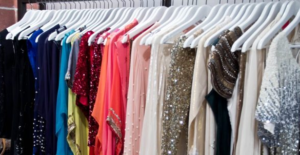
Sadly, while recent progress is encouraging, the fashion industry has been slow to innovate in this area. Sustainability tends to sit in the corporate social responsibility arm of fashion companies, far from the design department. Growth in this area could be seen at the Future Fabrics Expo in London, which showcases sustainable textiles being developed at a commercial level.
Looking ahead, we need alternative fabrics & to talk about them: Pros and Cons of second hand, slow & fair fashion, vegan, organic cotton, clothing swaps, minimalism, local production and recycled materials.
And for consumers this means thinking about what you buy, knowing which philosophies you are supporting through your purchases. Tell stories digitally and make them viral. Fashion branding should take less the fashion show route, more the fashion talk route around sustainability & responsible buying. Another super sustainable solution is vintage clothing or buy second hand, because the pieces already exist, so you are saving the entire negative impact of production. Buying high quality second hand or vintage pieces is the best way to go, if your budget allows it.
Ensuring fair wages supports education and directly improves worker’s quality of life. Also, garment transport puts out a huge amount of C02, which can be reduced by minimizing the distances during production. So the eco-system of fashion must encourage local production.
Using & propagating organic cotton as it saves us from pesticides and is better for the health and land of the farmers, and also protects wildlife. Organic is always better, however fabrics like tencil, lensing, and hemp offer comparable qualities and need less water for production. This entails a battle against genetically modified BT cotton which has taken Indian cotton farming by the storm, sadly with political backing.
It must also be noted that the Khadi and Village Industries Commission of India (KVIC) defines khadi as cloth that “is hand-woven using hand-spun thread,”. However, many a time, factory-made cloth is passed off as khadi. Customers are fooled, since the texture of this fake cloth is rough, which most mistakenly think is the way to gauge for khadi. KVIC had issued notices to more than 300 institutions and local khadi bhandars for passing off mill-made cloth as khadi. A series of cases are on the ethnic clothes and accessory giant Fabindia also for using mill-made fabric and calling that khadi.
So Happy Fashion of tomorrow needs to focus on the 3R’s of the Environment: Reduce, Reuse, and Recycle; and 3 Legs of Sustainability”: Economics, Ecology, and Social Equity, using Natural and Organic Fibers as much as possible, not harming animals.
Venturing into a new industry is difficult and choosing to take a stand on environmental sustainability and ethical manufacturing practices will require serious dedication, but the effort will eventually put you into contact with amazing craftspeople, dedicated manufacturers, and people around the globe who care about the future of our planet.
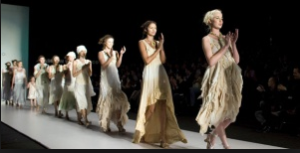
Sustainable Fashion Brands, Companies, Organizations:
- Eastern European prisoners are designing sustainable prison fashion in Latvia and Estonia under the Heavy Eco label, part of a trend called “prison couture”.
- Ryan Jude Novelline created a ballroom gown constructed entirely from the pages of recycled and discarded children’s books: The Golden Book Gown
- Eco-couture designer Lucy Tammam uses eri silk (ahimsa/peace silk) and organic cotton to create her eco friendly couture evening and bridal wear.
- The brand Boll & Branch make all of their bedding products from organic cotton and have been certified by Fair Trade USA.
- Pact, a brand that produced Fair Trade Factory Certified™ clothing made out of organic cotton.
- People Tree is a brand that actively supports farmers, producers and artisans through 14 producer groups, in 6 countries.
- The National Association of Sustainable Fashion Designers, US, supporting the designers.
- Red Carpet Green Dress, founded by Suzy Amis Cameron, global initiative showcasing sustainable fashion on the red carpets at the Oscars
- Undress Brisbane is an Australian fashion show that sheds light on sustainable designers in Australia
- Ecoluxe London, biannual exhibition during London Fashion Week and showcasing eco-sustainable and ethical designers.
- Fashion Takes Action is an organisation that promotes sustainable fashion via social media, PR, hosting fashion shows, public talks, school lectures and conferences.
- The Ethical Fashion Initiative, a flagship program of the International Trade Centre, a joint agency of the United Nations Conference on Trade and Development (UNCTAD) and World Trade Organization
- Eco Age, a consultancy company specializing in enabling businesses to achieve growth and add value through sustainability
- Trans-America Trading Company is one of the biggest of about 3,000 textile recyclers in the United States.
- ViaJoes – Sustainable clothing manufacturer producing Eco friendly fabrics from recycled cotton and other sustainable products confirmed to GOTS – Global Organic Textile Standard International Working Group standard.
Look Good with a Clear Conscience: Few Sustainable Brands:
- Misha Nonoo
- Best-selling ‘Easy 8’ collection shows that with eight pieces that come together to create 22 different looks
- BITE (an acronym for By Independent Thinkers for Environmental Progress)
- The minimalist, collection, made using certified organic fabrics, comprises 20 fixed styles which are updated seasonally, promoting the idea of timeless clothes that are made to last
- Jordan Nodarse has launched his own denim sustainable brand Boyish Jeans uses sustainable
- Bethany Williamsis the deserving winner of the 2019 Queen Elizabeth II Prize for Design, working with women’s rehab centres and refugees to create original street-wear with strong social conscience and sustainability.
- Sustainable footwear brand Allbirds has sold over a million pieces to trainers. Timedescribed the label’s offering as “the world’s most comfortable shoe.
- Alice Early’s work is characterized by minimalist utilitarianism- all her cotton is Global Organic Textile Standard Certified.
- Kit Willow’s brand Kitx, that works with artisans in India, is built on a belief of ethical, sustainable fashion.
- Reformation creates effortless feminine silhouettes from sustainable fabrics, such as rescued old stock materials and re purposed vintage clothing.
- Ninety Percent – which offers relaxed day wear in dreamy fabrics – works upon a unique premise. It shares 90 per cent of its distributed profits between charitable causes and those who make their collections happen.
- Stella McCartney: Cruelty-free—no fur or leather, use re engineered cashmere & ethically-sourced wool, organic cotton & recycled textiles
- Eileen Fisher: Organic, recycled, & sustainable garments, natural dyes; inclusive & petite sizes for women, minimalist staples
- Rag & Bone: Denim recycling program, redefining urban style as it is about sustainability and local production.
- Mara Hoffman: Uses recycled fabrics & fibers, hemp, linen, & organic cotton, sustainable packaging & branding
- DÔEN: Natural fabrics and timeless dresses and elevated women’s wear.

(This article is based on the author’s keynote address in Debrecen Fashion Film Festival in Hungary on May 8. The author is the Dean of Pearl Academy and former Dean of Symbiosis and Amity Universities.)






















